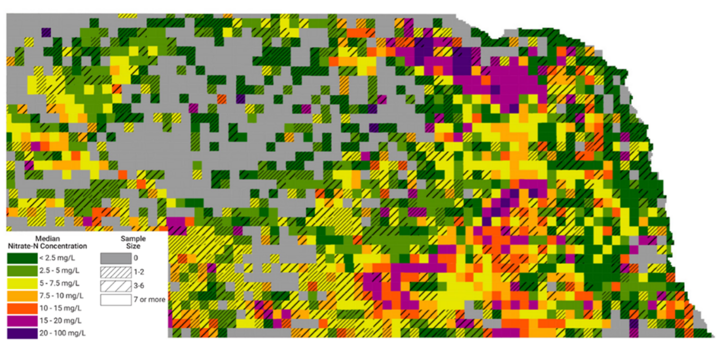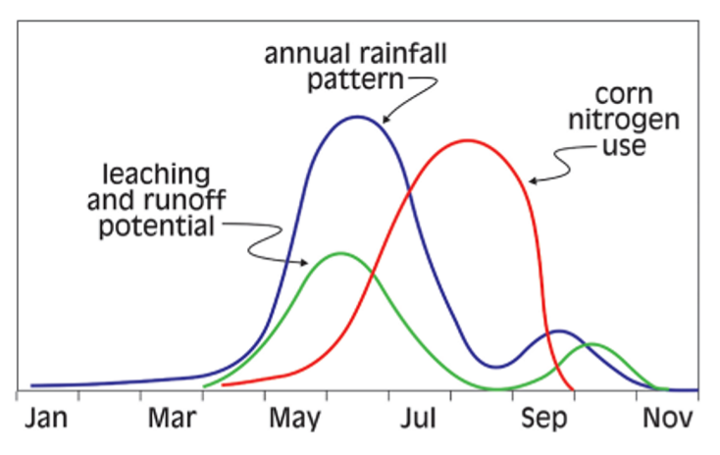Key Takeaways
- In many locations, irrigation water can provide significant, valuable in-season fertilizer.
- The amount of nitrogen depends on the concentration of nitrate and amount irrigated.
Nitrogen continues to be one of the highest cropping system input expenses with irrigated corn. In many parts of Nebraska, there is a significant amount of nitrogen available in groundwater as nitrate. When applied through irrigation, this nitrate is readily available to crops and is a free source of fertilizer.

How Much Nitrogen is in My Irrigation Water?
The amount of nitrate in water is measured as parts per million (ppm) or milligrams per liter (mg/L), these are the same measure for nitrate. Each ppm will add 0.227 pounds of nitrogen per acre with each inch of irrigation water applied. Table 1 below shows the total pounds per acre of applied nitrogen:
| Nitrate-Nitrogen (ppm or mg/L) | Irrigation applied (in) | ||||||||||||||
|---|---|---|---|---|---|---|---|---|---|---|---|---|---|---|---|
| 1 | 2 | 3 | 4 | 5 | 6 | 7 | 8 | 9 | 10 | 11 | 12 | 13 | 14 | 15 | |
| 5 | 1 | 2 | 3 | 5 | 6 | 7 | 8 | 9 | 10 | 11 | 12 | 14 | 15 | 16 | 17 |
| 10 | 2 | 5 | 7 | 9 | 11 | 14 | 16 | 18 | 20 | 23 | 25 | 27 | 29 | 32 | 34 |
| 15 | 3 | 7 | 10 | 14 | 17 | 20 | 24 | 27 | 31 | 34 | 37 | 41 | 44 | 48 | 51 |
| 20 | 5 | 9 | 14 | 18 | 23 | 27 | 32 | 36 | 41 | 45 | 50 | 54 | 59 | 63 | 68 |
| 25 | 6 | 11 | 17 | 23 | 28 | 34 | 40 | 45 | 51 | 57 | 62 | 68 | 74 | 79 | 85 |
| 30 | 7 | 14 | 20 | 27 | 34 | 41 | 48 | 54 | 61 | 68 | 75 | 82 | 88 | 95 | 102 |
| 35 | 8 | 16 | 24 | 32 | 40 | 48 | 56 | 63 | 71 | 79 | 87 | 95 | 103 | 111 | 119 |
| 40 | 9 | 18 | 27 | 36 | 45 | 54 | 63 | 73 | 82 | 91 | 100 | 109 | 118 | 127 | 136 |
| 45 | 10 | 20 | 31 | 41 | 51 | 61 | 71 | 82 | 92 | 102 | 112 | 122 | 133 | 143 | 153 |
| 50 | 11 | 23 | 34 | 45 | 57 | 68 | 79 | 91 | 102 | 113 | 125 | 136 | 147 | 159 | 170 |
To find out how much nitrate-nitrogen is in your irrigation water, we recommend that you test each well every few years. Also check with your local NRD for testing requirements in water quality phase areas. Nitrate levels can vary significantly from well-to-well and nitrate levels are changing over time across much of the state. (Note: some water test results are reported as nitrate (NO-3), others are reported as nitrate-nitrogen (NO3-N). The calculations in this article are based on nitrate-nitrogen. Nitrate-nitrogen = 0.226 x nitrate).
When Will Fertilizer from Irrigation Water Be Available?
The timing of irrigation application in relation to the period of rapid nitrogen uptake by the crop affects the value of the nitrogen in the water to that year’s crop. The most rapid N uptake extends from about V6 to after pollination, but N is taken up all season. Nitrogen in irrigation water applied during the rapid uptake period is just as useful to the crop as the same amount of nitrogen fertilizer. Nitrogen in water applied late in the growing season — after the crop has already taken up most of its nitrogen needs — is of limited value for this year's crop.
Care must be taken to reduce drainage below the root zone since nitrogen will leach with water from rain or irrigation. So, since rain is unpredictable, irrigation scheduling should leave as much rain storage room in the soil as is practical while optimizing yields.

Calculating Your Field’s Irrigation Water Nitrogen Credit
Due to the uncertainty of precipitation during the growing season, we suggest that the nitrogen contained in 80% of the five-year average irrigation depth be used when calculating the N contribution by irrigation water. If your field site is within an NRD with an annual water allocation, use the annual allocation in place of the five-year average. The example shows how to calculate the nitrogen provided by irrigation water.
Example
Irrigation water contains 15 ppm nitrate-nitrogen (NO3-N). The five-year average irrigation water application depth is 10 inches per year. Using 80% of the five-year average, how much crop available N is in the irrigation water?
80% x (NO3-N ppm) x (0.2267) x (in. of irrigation) = pounds of nitrogen/acre
0.8 x 15 ppm x 0.227 x 10 in. = 27 lb of nitrogen/acre added through irrigation
Adjusting In-season
Predicting how much nitrogen and irrigation water will be needed for a given field this coming summer in January or February is difficult. However, good in-season techniques are now available to help determine the optimal rates of irrigation and nitrogen to produce optimum yields. Center pivot and SDI irrigation systems provide an easy method to make in-season application. We recommend applying a lower rate of nitrogen in the spring, followed by monitoring the crop to see if additional nitrogen is needed.

